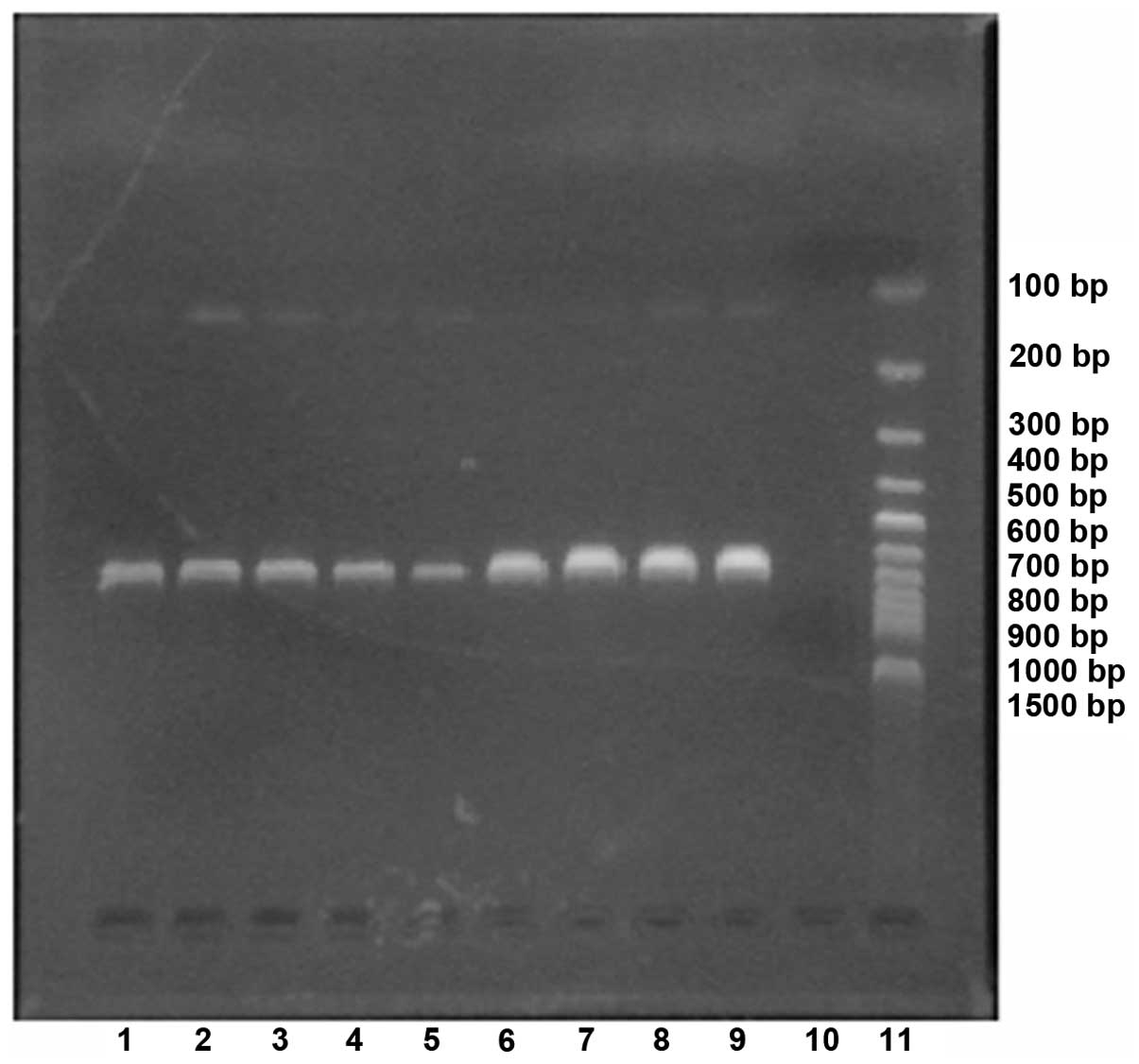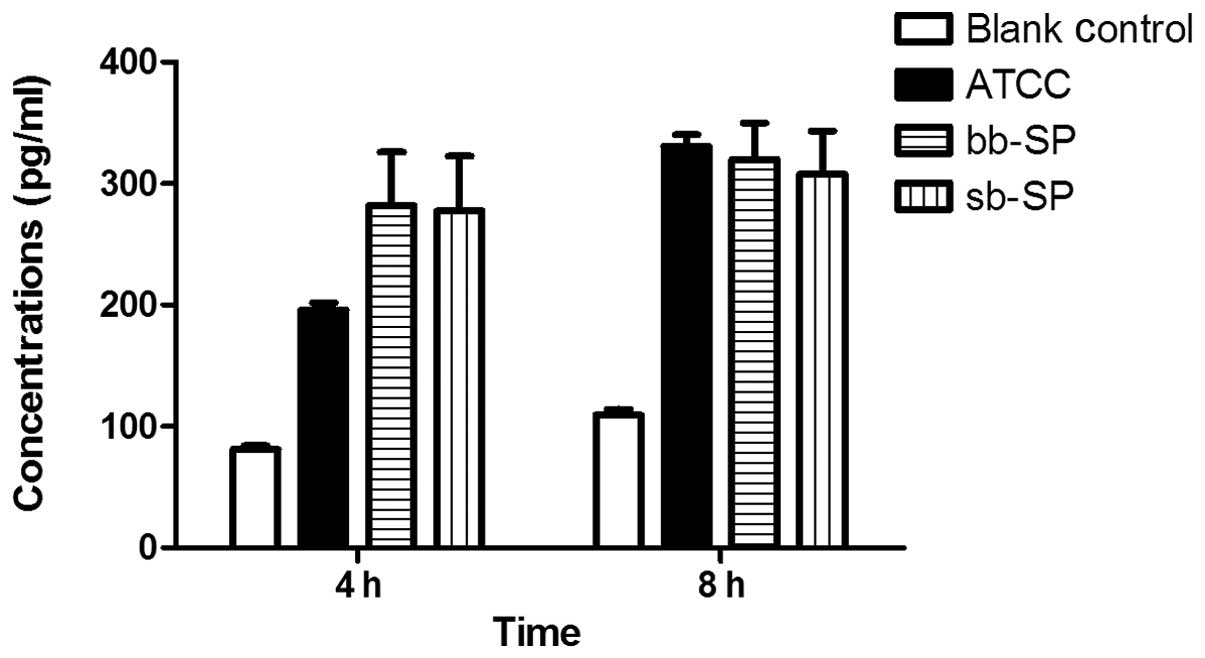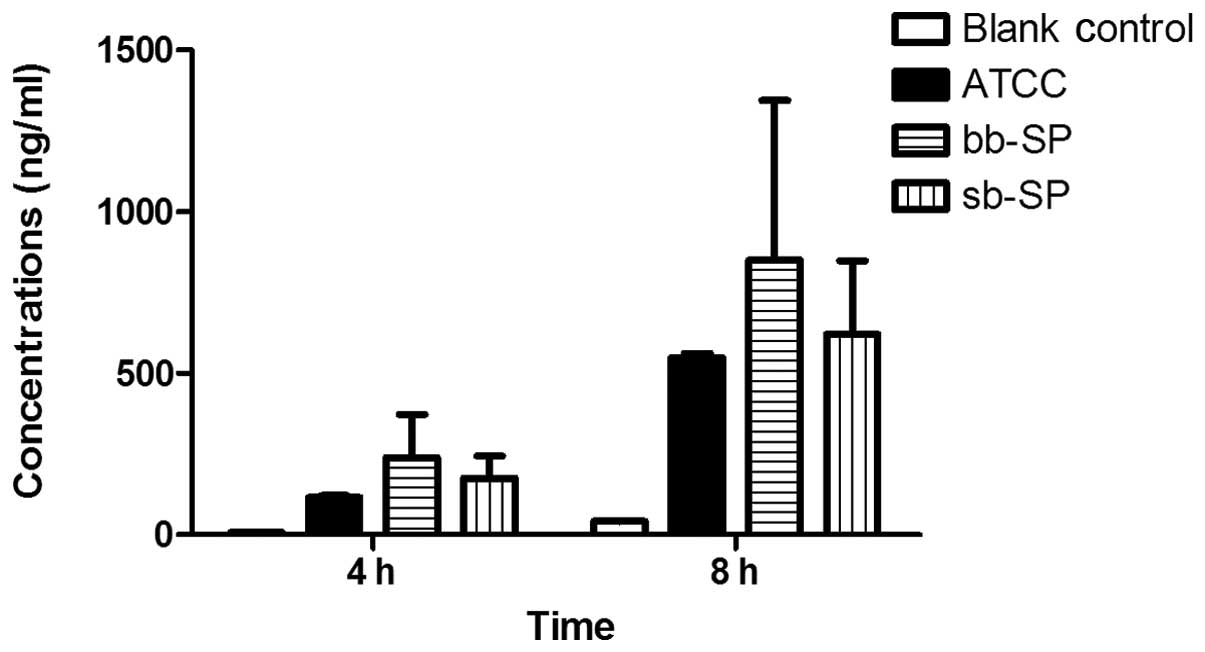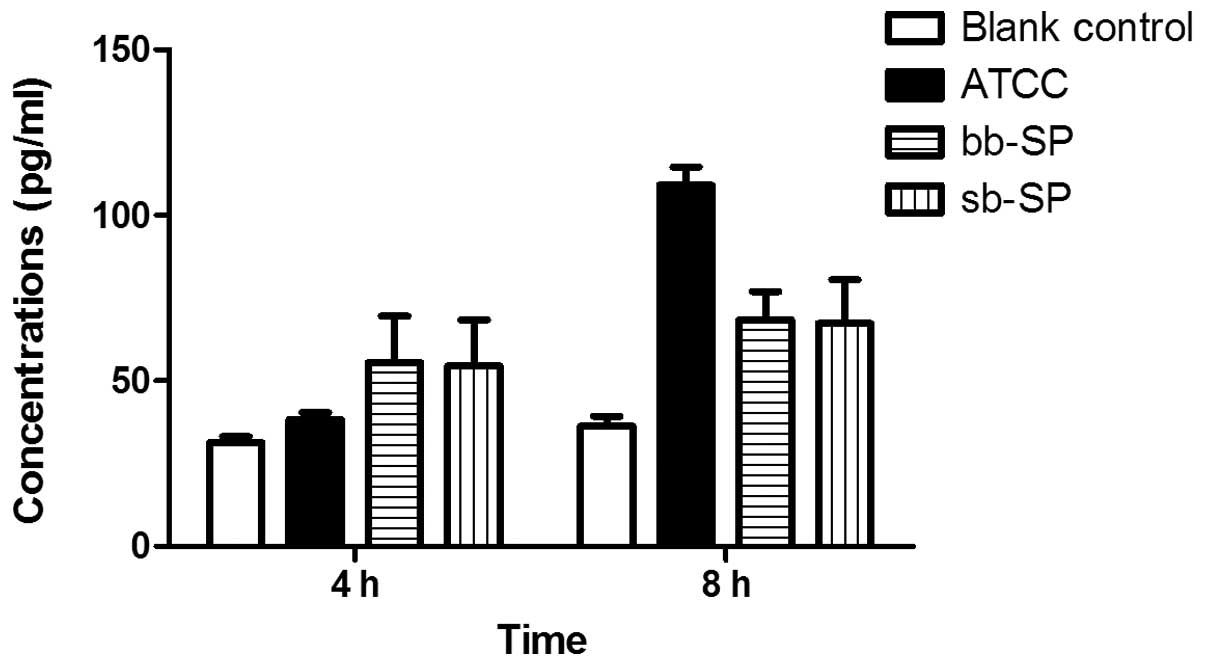Effects of clinical isolates of Streptococcus pneumoniae on THP-1 human monocytic cells
- Authors:
- Published online on: September 17, 2013 https://doi.org/10.3892/mmr.2013.1688
- Pages: 1570-1574
Abstract
Introduction
Streptococcus pneumoniae (SP), discovered in 1881, is a gram-positive Streptococcus and a predominant pathogen that results in community-acquired pneumonia, otitis media, meningitis, abscesses and other infections. These infections occur particularly in infants, young children and elderly adults (1). In developing countries, up to 1 million children under the age of five suffer from fatal pneumonia annually, in which SP is the predominant pathogen (2). SP infections may result in high levels of morbidity and mortality; however, SP often exists as an opportunistic pathogen in the upper respiratory tract of asymptomatic carriers (3) and it is difficult to determine when it will become pathogenic. During the colonization and invasion, particularly in the development of blood-borne (bb) infections, such as infections of the blood and cerebrospinal fluid (CSF), there are complex interactions between SP and the host immune system. Various components of SP are involved in the immune response, such as capsular and virulence factors (4–6). Furthermore, a variety of cells from the host immune system (such as neutrophils, monocytes/macrophages and dendritic cells) are also involved in the response (5–8), and a variety of factors [such as interleukin (IL)-1α, IL-1β, IL-6, interferon (IFN)-α, IL-8 and intracellular adhesion molecule-1 (ICAM-1)] are released (3,8,9).
Currently, studies are focusing on the mechanisms of SP resistance and pathogenesis. Sepsis and meningitis accounted for ~5% of the total number of SP infections; however, the resulting morbidity is markedly greater (>30%) than that of other types of SP infection (10,11). Neurological complications are the predominant cause of death in children, while systemic complications are the predominant cause in the elderly. There are only a few studies that have analyzed the mechanism of SP invasion into the circulatory and nervous systems, which may be due to the small number of clinical cases available to observe. As described previously, the progression of the SP infection involves the interaction between the host immune system and various SP virulence factors. SP has >10 types of virulence factors, including NanA, CpsA, CbpA, PsaA, PspA, PspC and Ply (2). The virulence factors are involved in different processes and may contribute to the different types of SP infection (6,12,13).
THP-1 cells are monocytes derived from human monocytic leukemia, and are currently predominantly used for the study of the pathogenesis of SP. Thornton and McDaniel (9) confirmed that Ply upregulated ICAM-1 secretion in THP-1 cells. The majority of current studies focus on individual cytokines or virulence factors; however, usually more than one virulence factor is involved in SP invasion and pathogenesis. The differences among SP invasions are predominantly due to two key factors. The response of different hosts to SP and the reaction of SP to different host cells results in different invasion outcomes. For example, it may determine whether cells are not infected, are carriers or exhibit an apparent infection. With an apparent infection, ~80–90% of patients present with pneumonia symptoms, while 5% of patients suffer from SP bacteremia, sepsis or SP CSF infection, the mortality of which is markedly higher than that of the SP pneumonia infection. The interaction between SP and the host is complex, thus, in this study, representative cytokines and adhesion molecules were selected and different sources of SP were used as stimuli for THP-1 cells. Changes in the levels of the secretion of IL-8 and IL-10 cytokines and ICAM-1 adhesion molecule were investigated, and the biological characteristics of SP from different sources were compared.
Materials and methods
Strains and cells
The ATCC 49619 SP standard strain was provided by the China Medical Culture Collection Center (Beijing, China). Twenty-three clinical SP strains were isolated in 2009 from the Second Affiliated Hospital of Wenzhou Medical College (Wenzhou, Zhejiang, China), among which 11 were isolated from blood samples, marked as bb strains and 12 from sputum specimens, marked as sputum-borne (sb) strains. The species of the strains were identified by a VITEK-32 (bioMérieux Inc., Marcy-Etoile, France) automatic microbial analyzer GPI card (bioMérieux Inc.), and confirmed by an SP species-specific PCR assay. THP-1 cells were purchased from the Shanghai Cell Bank of Chinese Academy of Sciences (Shanghai, China).
Reagents and instruments
The following reagents and instruments were used in the study: Fetal bovine serum (Zhejiang Tianhang, Hangzhou, China); RPMI-1640 culture medium and F-12K culture medium (Gibco-BRL, Carlsbad, CA, USA); PCR primers (Shanghai Shanjing, China); 3111 type CO2 incubator (Thermo Electron Corp., Madison, WI, USA); VITEK-32 automatic microorganism analyzer (bioMérieux Inc., Marcy-Etoile, France); Mastercycler PCR instrument (Eppendorf, Germany); Wellscan MK 3-type microplate reader and the Wellwash 4 MK2 washer (Thermo Electron Corp.); WD-9413A gel imaging analyzer (Beijing Liuyi Instrument Factory, Fengtai, Beijing, China); and the PAC3000 type electrophoresis apparatus (Bio-Rad, Hercules, CA, USA).
Cell culture
THP-1 cells were cultured in RPMI-1640 culture medium (supplemented with 1% penicillin and 10% fetal calf serum) and incubated at 37ºC in a 5% CO2 atmosphere. The cells (less than seven generations) were collected and RPMI-1640 medium (supplemented with 10% inactivated fetal bovine serum) was added to adjust the concentration to 4.0×108 cells/l.
The 23 clinical SP strains and the ATCC 49619 standard strain were cultured and suspended in normal saline (at a turbidity of 1.0 McFarland).
THP-1 cell stimulation
The THP-1 cell suspension (1.2 ml) was distributed into 60 wells of the cell culture plate, wherein 12 wells were selected as controls. SP suspension (100 μl) was added to each well, the control wells were filled with 100 μl saline and the plate was incubated at 37ºC in a 5% CO2 atmosphere. After 4 h, the solutions in 30 wells (including six controls) were transferred to 1.5-ml microcentrifuge tubes and centrifuged at 1,789 × g for 10 min. The supernatants were stored at −80ºC for further determination. After 8 h, solutions in the other 30 wells (including six controls) were treated as described previously.
ELISA assay for IL-8, ICAM-1 and IL-10
A double antibody sandwich ABC-ELISA method was used. The anti-human IL-8, ICAM-1 and IL-10 monoclonal antibodies (mAbs) were coated onto a microtiter plate and were allowed to combine with the IL-8, ICAM-1 and IL-10 in the standards and samples. Subsequent to this, biotinylated anti-human IL-8, ICAM-1 and IL-10 mAbs were added. The immune complexes formed and the streptavidin-labeled horseradish peroxidase combined with the complexes. The chromogenic substrate was then added followed by the stop solution. The optical density (OD) values at 450 nm were measured. The IL-8, ICAM-1 and IL-10 concentrations were proportional to the OD values, thus the IL-8, ICAM-1 and IL-10 concentrations in the specimens were determined according to the obtained standard curve. This was conducted according to the manufacturer’s instructions.
pbp2B detection
To prepare DNA templates, 15–20 pure colonies of SP were isolated from blood agar and placed into 0.5-ml centrifuge tubes containing 200 μl dH2O. The isolates were then placed in a boiling water bath for 30 min, removed and placed in a −20ºC freezer for 10 min. Subsequent to this, they were centrifuged at 16,099 × g for 30 sec and the resulting supernatants were transferred to 0.5-ml centrifuge tubes. For PCR amplification, the primers used were as previously reported (14): Forward: 5′-CTGACCATTGATTTGGCTTTCCAA-3′ and reverse: 5′-TTTGCAATAGTTGCTACATACTG-3′ for the target gene pbp2B, 682 bp. The PCR reaction conditions were as follows: 94ºC denaturation for 5 min, 94ºC for 30 sec, 55ºC for 1 min and 72ºC for 1 min for 30 cycles, and 72ºC for 10 min. Electrophoresis was conducted using 5 μl PCR product, 1 μl 6X loading buffer was loaded onto 2.0% agarose gel and 150 V and 75 mA electrophoresis was conducted for 25 min. The electrophoresis results were acquired by a gel camera system (WD-9413A gel imaging analyzer).
Statistical analysis
Data are expressed as the mean ± standard deviation. Single-factor analysis of variance was performed using SPSS, version l7.0 (SPSS, Inc., Chicago, IL, USA). Normality was analyzed using the Kolmogorov-Smirnov test, and homogeneity of variance was analyzed using the Levene test. Clinical SP (including the bb and sb strains) and the blank control group or ATCC group were compared using a one-sample t-test. When variances were unequal, comparisons between the bb-SP and sb-SP groups were performed using the Satterthwaite approximate two-sample t-test. When variances were equal, comparisons between the bb-SP and sb-SP groups was performed using variance analysis. The following criteria were applied: Normality test, P>0.10 and homogeneity of variance test, P>0.10. P<0.05 was considered to indicate a statistically significant difference.
Results
PCR of the SP pbp2B gene
The results of the electrophoresis for the PCR product of the SP pbp2B gene is shown in Fig. 1.
IL-8 secretion by THP-1 cells following SP stimulation
Compared with the blank control group, the levels of IL-8 secreted by the THP-1 cells were significantly increased in the bb-SP and sb-SP groups following 4 and 8 h treatment. Compared with the cells treated with the ATCC 49619 positive control, THP-1 cells treated with bb-SP and sb-SP for 4 h secreted greater levels of IL-8 (P<0.05); however, no significant difference was observed after 8 h. Levels of IL-8 secreted by the THP-1 cells following 8 h stimulation with SP were higher than those at 4 h (P<0.05), indicating that the IL-8 concentration increased with stimulation time. At the two time points, there was no statistically significant difference between the bb-SP and sb-SP groups (Fig. 2).
ICAM-1 secretion by THP-1 cells following SP stimulation
The results for the ICAM-1 secretion were similar to those for IL-8. Compared with the blank control group, the levels of ICAM-1 secreted by the THP-1 cells were significantly increased in the bb-SP and sb-SP groups following treatment for 4 and 8 h. In addition, compared with the cells treated with the ATCC 49619 positive control, THP-1 cells treated with bb-SP and sb-SP for 4 h secreted greater levels of ICAM-1 (P<0.05); however, there were no significant differences after 8 h. The levels of ICAM-1 secreted by the THP-1 cells subsequent to 8 h of stimulation with SP were greater than those at 4 h (P<0.05), indicating that the ICAM-1 concentration increased with stimulation time. At the two time points, there was no significant difference between the bb-SP and sb-SP groups (Fig. 3).
IL-10 secretion by THP-1 cells following SP stimulation
Compared with the blank control group, the levels of IL-10 secreted by the THP-1 cells were significantly increased in the bb-SP and sb-SP groups following treatment for 4 and 8 h. Compared with the cells treated with the ATCC 49619 positive control, THP-1 cells treated with bb-SP and sb-SP for 4 h secreted more IL-10; however, after 8 h these cells secreted less (P<0.05). Levels of IL-10 secreted by the THP-1 cells following 8 h stimulation with SP were higher than those for 4 h (P<0.05), indicating that IL-10 concentration increased with stimulation time. At the two time points, there was no significant difference between the bb-SP and sb-SP groups (Fig. 4).
Discussion
IL-8, also termed chemokine factor 8, is secreted by monocytes/macrophages and epithelial cells. It promotes the accumulation and activation of inflammatory cells, the release of inflammatory mediators and aids in neutrophil chemotaxis to sites of inflammation to regulate the inflammatory response (15,16). This process is an important response to SP infection and is essential for the body to maintain stability and remove foreign microbes. As shown in Fig. 2, the bb-SP and sb-SP increased the level of IL-8 secretion in THP-1 cells, consistent with the results of previous studies (17,18), and significant differences were observed between clinical SP and ATCC 49619 groups at 4 h. bb-SP demonstrated a similar ability to sb-SP with regard to stimulation of THP-1 cells to secrete IL-8. It is suggested that the IL-8 levels secreted by THP-1 cells may not be elevated infinitely following SP stimulation (19). THP-1 cells which were not stimulated also secreted a low level of IL-8, and the concentration increased slowly with the incubation time; therefore, this low level of IL-8 may aid in the proliferation of THP-1 cells.
ICAM-1 is one of the earliest discovered immune protein superfamily adhesion molecules and it combines with the lymphocyte function-associated antigen 1 (LFA-1) (4). ICAM-1 is widely distributed in numerous types of cells, including lymph node and tonsil vascular endothelial cells, thymic dendritic cells, tonsil and glomerular epithelial cells, leukocytes, macrophages and fibroblasts. IL-1, TNF-α, IFN and LPS are able to promote the expression of ICAM-1 molecules. As shown in Fig. 3, the bb-SP and sb-SP increased the levels of IL-10 secretion in the THP-1 cells, which has been previously demonstrated to enhance the interaction of ICAM-1 with its receptor and promote leukocyte accumulation in infected lesions, particularly the extravascular lesions (20,21). This is important for the body to remove foreign microbes and maintain stability. Secretion of ICAM-1 from THP-1 cells stimulated by SP increased with time, and reached a peak at ~8 h (9). However, it is considered that the ICAM-1 concentration following SP stimulation of THP-1 cells is not infinitely increased, as it would result in significant damage to the body (22). In the present study, significant differences existed between the clinical SP and ATCC 49619 groups at 4 h. bb-SP showed a similar ability to as sb-SP to with regard to stimulation of THP-1 cells. In addition, THP-1 cells which were not stimulated also secreted a low level of ICAM-1, and the concentration increased slowly with the incubation time. This low level of ICAM-1 is the basis for the implementation of the immune defense functions.
IL-10 is predominantly produced by T helper cell 2 (TH2) cells. In addition, IL-10 is also be secreted by TH0 cells, monocytes/macrophages and B cells. IL-10 is predominantly anti-inflammatory and is involved in the inhibition of the antigen-presenting function of macrophages, inhibition of the response of TH1 cells, promotion of B cell proliferation, differentiation and antibody production, and the indirect inhibition of NK cell activity. It therefore exerts a protective effect on the body by preventing an excessive inflammatory reaction. As shown in Fig. 4, the bb-SP and sb-SP increased the IL-10 secretion by THP-1 cells and significant differences existed between the clinical SP and ATCC 49619 groups. bb-SP demonstrated a similar ability to sb-SP in stimulating THP-1 cells to secrete IL-10.
In conclusion, the bb-SP and sb-SP exhibited similar abilities in increasing the levels of secretion of IL-8, ICAM-1 and IL-10 by THP-1 cells, however, this differed from that of ATCC 49619. In conclusion, the host’s reaction did not appear to be the predominant factor in the cause of different types of SP infection (such as lung and blood infections); therefore, the biological characteristics of SP itself may have an important involvement and thus require further investigation.
Acknowledgements
This study was supported by a grant from the Science and Technology Bureau of Taizhou Jiaojiang (grant no. 10275).
References
|
Jin P, Xiao M, Kong F, et al: Simple, accurate, serotype-specific PCR assay to differentiate Streptococcus pneumoniae serotypes 6A, 6B, and 6C. J Clin Microbiol. 47:2470–2474. 2009. View Article : Google Scholar : PubMed/NCBI | |
|
Mahdi LK, Ogunniyi AD, LeMessurier KS and Paton JC: Pneumococcal virulence gene expression and host cytokine profiles during pathogenesis of invasive disease. Infect Immun. 76:646–657. 2008. View Article : Google Scholar : PubMed/NCBI | |
|
Suzuki H and Ikeda K: Mode of action of long-term low-dose macrolide therapy for chronic sinusitis in the light of neutrophil recruitment. Curr Drug Targets Inflamm Allergy. 1:117–126. 2002. View Article : Google Scholar : PubMed/NCBI | |
|
Morona JK, Morona R and Paton JC: Attachment of capsular polysaccharide to the cell wall of Streptococcus pneumoniae type 2 is required for invasive disease. Proc Natl Acad Sci USA. 103:8505–8510. 2006. View Article : Google Scholar : PubMed/NCBI | |
|
Cockeran R, Mitchell TJ, Feldman C and Anderson R: Pneumolysin induces release of matrix metalloproteinase-8 and -9 from human neutrophils. Eur Respir J. 34:1167–1170. 2009. View Article : Google Scholar : PubMed/NCBI | |
|
Uchiyama S, Carlin AF, Khosravi A, et al: The surface-anchored NanA protein promotes pneumococcal brain endothelial cell invasion. J Exp Med. 206:1845–1852. 2009. View Article : Google Scholar : PubMed/NCBI | |
|
Hyams C, Camberlein E, Cohen JM, et al: The Streptococcus pneumoniae capsule inhibits complement activity and neutrophil phagocytosis by multiple mechanisms. Infect Immun. 78:704–715. 2010. | |
|
Robson RL, Reed NA and Horvat RT: Differential activation of inflammatory pathways in A549 type II pneumocytes by Streptococcus pneumoniae strains with different adherence properties. BMC Infect Dis. 6:712006. View Article : Google Scholar : PubMed/NCBI | |
|
Thornton J and McDaniel LS: THP-1 monocytes up-regulate intercellular adhesion molecule 1 in response to pneumolysin from Streptococcus pneumoniae. Infect Immun. 73:6493–6498. 2005. View Article : Google Scholar : PubMed/NCBI | |
|
Koedel U, Scheld WM and Pfister HW: Pathogenesis and pathophysiology of pneumococcal meningitis. Lancet Infect Dis. 2:721–736. 2002. View Article : Google Scholar : PubMed/NCBI | |
|
Weisfelt M, van de Beek D, Spanjaard L, et al: Clinical features, complications, and outcome in adults with pneumococcal meningitis: a prospective case series. Lancet Neurol. 5:123–129. 2006. View Article : Google Scholar : PubMed/NCBI | |
|
Schachern PA, Tsuprun V, Cureoglu S, et al: Virulence of pneumococcal proteins on the inner ear. Arch Otolaryngol Head Neck Surg. 135:657–661. 2009. View Article : Google Scholar : PubMed/NCBI | |
|
Littmann M, Albiger B, Frentzen A, et al: Streptococcus pneumoniae evades human dendritic cell surveillance by pneumolysin expression. EMBO Mol Med. 1:211–222. 2009. View Article : Google Scholar | |
|
du Plessis M, Smith AM and Klugman KP: Rapid detection of penicillin-resistant Streptococcus pneumoniae in cerebrospinal fluid by a seminested-PCR strategy. J Clin Microbiol. 36:453–457. 1998.PubMed/NCBI | |
|
Baggiolini M, Walz A and Kunkel SL: Neutrophil-activating peptide-1/interleukin 8, a novel cytokine that activates neutrophils. J Clin Invest. 84:1045–1049. 1989. View Article : Google Scholar : PubMed/NCBI | |
|
Ahuja SK, Ozçelik T, Milatovitch A, et al: Molecular evolution of the human interleukin-8 receptor gene cluster. Nat Genet. 2:31–36. 1992. View Article : Google Scholar : PubMed/NCBI | |
|
Spanaus KS, Nadal D, Pfister HW, et al: C-X-C and C-C chemokines are expressed in the cerebrospinal fluid in bacterial meningitis and mediate chemotactic activity on peripheral blood-derived polymorphonuclear and mononuclear cells in vitro. J Immunol. 158:1956–1964. 1997. | |
|
Martner A, Skovbjerg S, Paton JC and Wold AE: Streptococcus pneumoniae autolysis prevents phagocytosis and production of phagocyte-activating cytokines. Infect Immun. 77:3826–3837. 2009. View Article : Google Scholar | |
|
Yoon BN, Choi NG, Lee HS, et al: Induction of interleukin-8 from nasal epithelial cells during bacterial infection: the role of IL-8 for neutrophil recruitment in chronic rhinosinusitis. Mediators Inflamm. 2010:1–7. 2010. View Article : Google Scholar : PubMed/NCBI | |
|
Etzioni A: Adhesion molecules in leukocyte endothelial interaction. Adv Exp Med Biol. 408:151–157. 1996. View Article : Google Scholar : PubMed/NCBI | |
|
Springer TA: Traffic signals for lymphocyte recirculation and leukocyte emigration: the multistep paradigm. Cell. 76:301–314. 1994. View Article : Google Scholar : PubMed/NCBI | |
|
Kerr JR: Cell adhesion molecules in the pathogenesis of and host defence against microbial infection. Mol Pathol. 52:220–230. 1999. View Article : Google Scholar : PubMed/NCBI |













